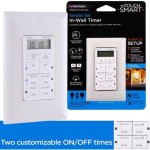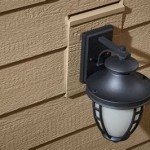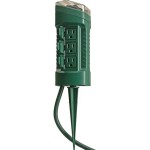```html
Outdoor String Lighting Ideas: Illuminating Your Outdoor Spaces
Outdoor string lighting offers a versatile and aesthetically pleasing method for enhancing the ambiance of various outdoor spaces. From intimate patios to expansive gardens, strategically placed string lights can transform ordinary areas into inviting and visually captivating environments. The selection and arrangement of string lights, however, require careful consideration to achieve the desired effect and maximize their impact.
This article will explore several outdoor string lighting ideas, addressing key factors such as light type, placement strategies, and power source options. By understanding these elements, individuals can effectively utilize string lights to create personalized and functional outdoor lighting solutions.
Selecting the Right Type of String Lights
The market offers a diverse range of string lights, each possessing unique characteristics that influence their suitability for particular applications. Factors to consider include bulb type, bulb size, wire gauge, and overall style.
Bulb Type: Common bulb types include incandescent, LED, and Edison-style bulbs. Incandescent bulbs offer a warm, traditional glow but are less energy-efficient and have a shorter lifespan compared to LEDs. LED bulbs, conversely, are highly energy-efficient, durable, and available in a spectrum of colors and brightness levels. Edison-style bulbs, characterized by their vintage aesthetic and exposed filaments, provide a unique and decorative lighting effect. The choice of bulb type hinges on balancing aesthetic preferences with energy efficiency and longevity requirements.
Bulb Size and Spacing: Bulb size and spacing significantly impact the overall illumination and visual appeal. Smaller bulbs, such as fairy lights, are ideal for creating subtle and delicate lighting effects, often used in gardens or for accent lighting. Larger bulbs, like globe lights, provide more substantial illumination and are suitable for larger spaces such as patios and decks. The spacing between bulbs also dictates the light intensity and coverage. Closer spacing results in brighter and more uniform illumination, while wider spacing creates a more scattered and ambient effect.
Wire Gauge and Durability: The wire gauge of the string lights determines their durability and resistance to weather elements. Thicker gauge wires are more robust and can withstand exposure to rain, wind, and extreme temperatures. For outdoor applications, it is crucial to select string lights specifically designed for outdoor use, featuring weather-resistant materials and construction. Inspecting the IP (Ingress Protection) rating of the lights can provide further information about their resistance to water and dust.
Style and Aesthetic: String lights are available in various styles, ranging from classic globe lights to whimsical novelty shapes. The choice of style should complement the overall aesthetic of the outdoor space. For example, rustic or farmhouse-style settings might benefit from Edison-style bulbs, while modern or contemporary spaces may favor sleek LED string lights. Coordinating the color of the wires and bulb housings with the surrounding décor can also enhance the visual harmony of the lighting arrangement.
Strategic Placement and Arrangement Techniques
The placement of string lights plays a critical role in achieving the desired lighting effect and optimizing the functionality of the outdoor space. Considering the existing structures, landscaping features, and intended use of the area is essential for effective placement.
Perimeter Lighting: Draping string lights along the perimeter of a patio, deck, or balcony is a popular and effective technique for defining the space and creating a warm, inviting atmosphere. Securing the lights to railings, fences, or overhead structures provides a clear and consistent line of illumination. This approach is particularly suitable for creating a sense of enclosure and enhancing the visual appeal of the area.
Overhead Canopies: Creating an overhead canopy of string lights can transform an open space into a magical and enchanting environment. This technique involves suspending string lights between trees, posts, or other supporting structures to form a ceiling of light. The density and arrangement of the lights can be varied to achieve different effects, from a dense and brightly lit canopy to a sparse and subtly illuminated one. This approach is ideal for creating a focal point in a garden or for providing ambient lighting for outdoor dining areas.
Tree and Shrub Illumination: Wrapping string lights around trees and shrubs can add a touch of whimsy and highlight the natural beauty of the landscape. Careful consideration should be given to the type of lights used and the method of attachment to avoid damaging the plants. Opting for LED fairy lights with flexible wires allows for easy wrapping and shaping around branches and foliage. This technique is particularly effective for creating a festive or celebratory atmosphere.
Pathways and Walkways: Illuminating pathways and walkways with string lights enhances safety and adds visual appeal to outdoor spaces. Strung along fences, railings, or low-lying plants, string lights can provide sufficient illumination to guide pedestrians and prevent tripping hazards. Solar-powered string lights are a convenient and energy-efficient option for pathway lighting, as they do not require access to electrical outlets.
Combining Lighting Layers: For a more sophisticated and layered lighting design, consider combining string lights with other types of outdoor lighting, such as spotlights, path lights, and wall sconces. This approach allows for greater control over the overall illumination and creates a more dynamic and visually interesting environment. For example, string lights can be used for ambient lighting, while spotlights can highlight specific architectural features or landscape elements.
Power Source Options and Installation Considerations
Choosing the appropriate power source and ensuring proper installation are crucial for the safe and reliable operation of outdoor string lights. Several power source options are available, each with its own advantages and disadvantages.
Plug-in String Lights: Plug-in string lights are the most common and straightforward option, requiring access to an outdoor electrical outlet. When using plug-in lights, it is essential to ensure that the outlet is GFCI (Ground Fault Circuit Interrupter) protected to prevent electrical shocks. Extension cords should be rated for outdoor use and properly shielded from the elements. This type is ideal for permanent or semi-permanent installations where a reliable power source is readily available.
Solar-Powered String Lights: Solar-powered string lights offer a convenient and energy-efficient alternative to plug-in lights. These lights feature a solar panel that charges a battery during the day, providing power for the lights to operate at night. Solar-powered lights are ideal for areas where access to electrical outlets is limited or where energy conservation is a priority. However, their performance can be affected by cloudy weather and the amount of sunlight they receive. Placement of the solar panel is key to their effectiveness.
Battery-Operated String Lights: Battery-operated string lights provide a portable and versatile lighting solution, suitable for temporary or mobile applications. These lights are ideal for decorating outdoor events, camping trips, or areas where neither electrical outlets nor sunlight are readily available. The battery life of these lights varies depending on the type of batteries used and the number of lights in the string. It's crucial to select lights that have a waterproof battery case for outdoor use.
Installation Safety: Proper installation is critical for ensuring the safety and longevity of outdoor string lights. Always follow the manufacturer's instructions carefully and take precautions to prevent electrical hazards. Avoid overloading electrical circuits and ensure that all connections are secure and weather-protected. When hanging string lights overhead, use sturdy hooks or wires to support the weight of the lights and prevent them from sagging. Furthermore, avoid hanging lights near flammable materials or heat sources.
Maintenance and Care: Regular maintenance can extend the lifespan of outdoor string lights and ensure their continued performance. Periodically inspect the lights for any signs of damage, such as cracked bulbs, frayed wires, or corroded connections. Clean the bulbs regularly to remove dust and debris that can reduce their brightness. During periods of inclement weather, consider removing or securing the lights to prevent damage from wind or snow. Storing lights properly during the off-season can also prolong their lifespan.
```
28 Backyard Lighting Ideas How To Hang Outdoor String Lights

13 Backyard String Light Ideas That Are Stunning Bob Vila

Outdoor String Light Ideas

Outdoor String Light Ideas Oclights

Outdoor String Lighting Ideas 10 Ways To Set The Ambience

Pin On Outdoor Spaces

How To Hang Outdoor String Lights A Step By Guide Govee

13 Backyard String Light Ideas That Are Stunning Bob Vila

27 Enchanting Patio String Lights Ideas To Adorn Your Backyard

15 Gorgeous Ways To Decorate With String Lights
Related Posts







